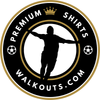Club Atlético Huracán is an Argentine sports club from the Parque Patricios neighbourhood, currently competing in the Primera División, founded on 1 November 1908, and offered here for collectors and fans via Walkouts. The team, often called El Globo or los Quemeros, is tied to the Nueva Pompeya and Parque Patricios districts of Buenos Aires, giving its shirts a strong sense of place and provenance.
Home fixtures are staged at the club’s traditional ground, the Estadio Tomás Adolfo Ducó, and Huracán’s museum and trophy room reflect a history that includes 13 domestic titles. The club’s modern profile is also visible in ranking lists, where it appears in IFFHS tables at 105, which collectors sometimes use as contextual provenance when cataloguing signed shirts.
Huracán shirts of interest to collectors range from anniversary issues to title-season releases. The club marked its centenary with a fan-focused release in 2008 that turns up regularly in auction archives, and centenary pieces often carry special badges or inscriptions that help with attribution and display narratives.
Derby provenance is a strong theme for Huracán, with the Clásico Porteño fixtures against San Lorenzo creating sought-after match connections. Fanshop and retail shirts are actively collected, not only match-worn pieces, and early retail runs, player-issue variants and region-specific releases from supplier eras are regularly tracked by enthusiasts and traders. Notes from collectors often point to Kappa production runs as a recognisable supplier era when verifying tags and stitching.
Season and match magnets drive much demand: shirts linked to the 1973 Metropolitano side and the club’s cup resurgence in the 2013-14 Copa Argentina era are particularly chased because they represent defining campaigns, while the club’s victory in the 2014 Supercopa is another provenance anchor. For signed retail pieces, documentation is crucial, and many sellers include a COA to support autograph claims, especially for framed or limited editions.
Collectors prize shirts connected to title nights at the Ducó and to away fixtures that decided cup ties, and provenance is often supported by signed photos or published match programmes. The Kappa supplier era and the centenary release in 2008 are recurring catalogue headings among dealers and private collections, and key seasons such as the 1973 Metropolitano and the 2014 Supercopa are routinely cited in lot descriptions on verified platforms.
Whether you seek framed shirts from the club’s championship years, retail-signed fan editions or limited runs from cup seasons, Walkouts closes this page with a reminder that Huracán pieces from the 1973 Metropolitano, the 2013-14 Copa Argentina campaign and the 2014 Supercopa remain among the most referenced in provenance notes and collector catalogues.







